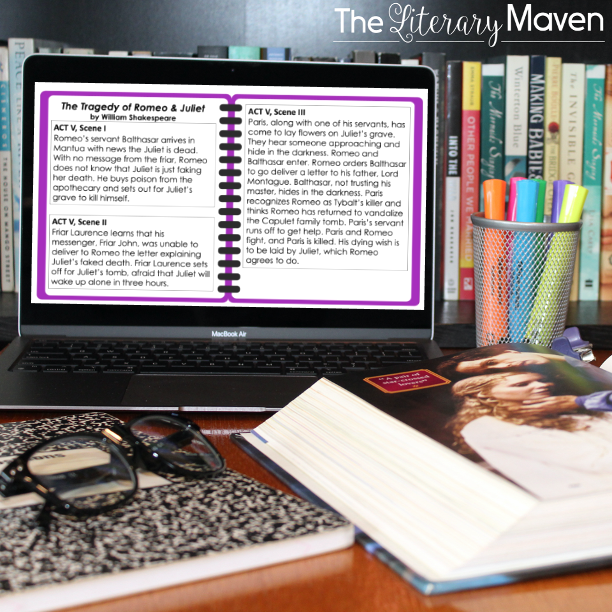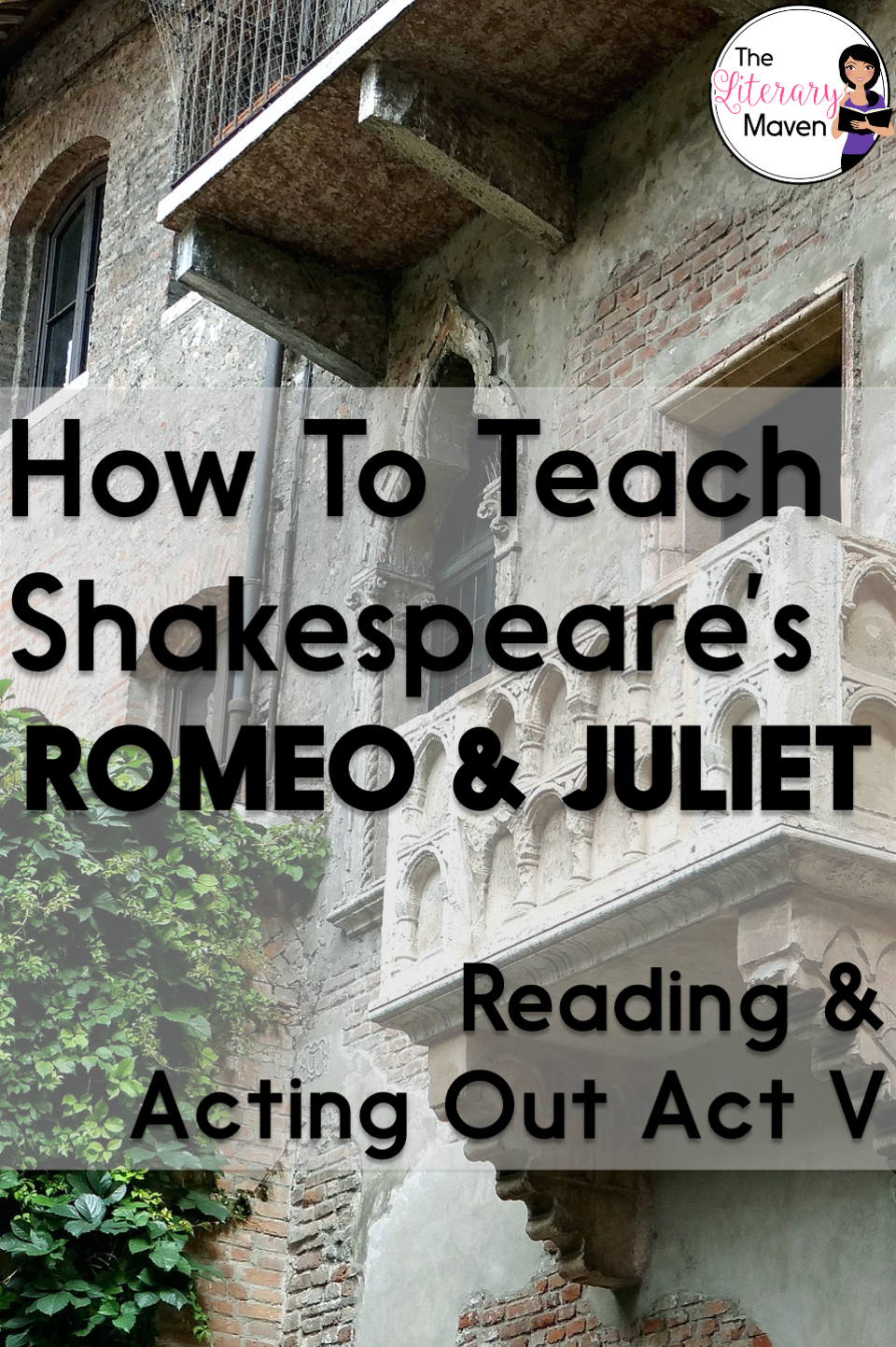Planning Out The Reading
I provide short summaries for any scenes we skip to fill students in on the less important events. I like to spend about a week on each act of the play, so the days we don't spend reading are spent on after reading activities, writing, and a short assessment.
Before jumping into this week's reading, we'll spend a few minutes reviewing the scenes from last week. I'll also review dramatic irony (introduced in Act IV) using examples from previous scenes and couplets, which I cover in a poetry unit earlier in the year.
Act V, Scene III
This scene is meant to be read independently because of the number of monologues. It includes summaries of Act V, Scene I; Act V, Scene II; and parts of Act V, Scene III. Then I provide the text of Act V, Scene II with the original text and the modern translations side by side. I edit the scene by cutting lines out. After reading, students translate words from the original to modern text, and vice versa. Then students answer short written response questions to demonstrate comprehension. We review this together at the end of class.
After Reading Activities

This scene is meant to be read independently because of the number of monologues. It includes summaries of Act V, Scene I; Act V, Scene II; and parts of Act V, Scene III. Then I provide the text of Act V, Scene II with the original text and the modern translations side by side. I edit the scene by cutting lines out. After reading, students translate words from the original to modern text, and vice versa. Then students answer short written response questions to demonstrate comprehension. We review this together at the end of class.
After Reading Activities
By the time the play ends, students have been on as much of an emotional roller coaster as the characters. They are often unsatisfied with the lack of specificity of the Prince's statement about pardons and punishments at the end of Act V, Scene III. I give students a chance to journal about who is to blame for the death of the two young lovers and what the punishment should be for those responsible. We also return to the idea of "what ifs" from Act IV. Students reflect on how both Romeo and Juliet and the adults in their lives could have acted differently to prevent such a tragic ending.
If I haven't already taught Shakespearean sonnets as a part of my poetry unit earlier in the year, I'll introduce them to the poetic form now. After reading one of Shakespeare's sonnets, I show my students the clip from 10 Things I Hate About You where Kat reads her “sonnet” to the class. I have my class decide if she is following the format of a Shakespearean sonnet (hint: she doesn't). You may have to play it several times for the students to make a decision.
Then we write some silly sonnets of our own. I start with a fill-in-the-blank template to help them get started with lines like "I love you like a kid loves birthday cake" and "I even love your stinky feet." We do some whole class brainstorming of words that rhyme with the provided lines and when finished, I let students share their favorite lines. Finally, I set students off to write a sonnet on their own. This one can be silly or serious. As students work on their own poems, I remind them of the rhyme scheme and if they are comfortable with that, I challenge them to also use iambic pentameter.
Then we write some silly sonnets of our own. I start with a fill-in-the-blank template to help them get started with lines like "I love you like a kid loves birthday cake" and "I even love your stinky feet." We do some whole class brainstorming of words that rhyme with the provided lines and when finished, I let students share their favorite lines. Finally, I set students off to write a sonnet on their own. This one can be silly or serious. As students work on their own poems, I remind them of the rhyme scheme and if they are comfortable with that, I challenge them to also use iambic pentameter.

Writing & Assessment
At the end of the week, I will give students a choice of two constructed response prompts, one connected to each of the scenes on which we focused. This is a chance for them to independently express their understanding of what we read, practice citing text evidence, and continue to build on their writing skills in general.
At the end of the week, I will give students a choice of two constructed response prompts, one connected to each of the scenes on which we focused. This is a chance for them to independently express their understanding of what we read, practice citing text evidence, and continue to build on their writing skills in general.
I also assign a text based assessment, which covers Act V. The assessment includes a section of Act V, ten multiple-choice questions, and two choices for a written response. Questions ask students to to analyze characters words and actions, to paraphrase important lines, and to define and give examples of dramatic irony and couplets.
You can find all of my resources for teaching Romeo and Juliet, including the materials described above that I use to teach Act V, here.
Read on for my approach to making real world connections to Romeo and Juliet. 





0 yorum:
Post a Comment